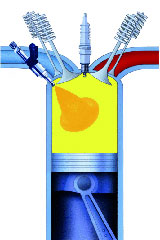Some of us are old enough to remember the carburetor. Some may still even have a vehicle with a carburetor, but it would have to be over 15 years old. The 1991 Subaru Justy was the last car with a carburetor sold in the U.S.

Today’s gasoline engines virtually all use multi-port fuel injection, or MPI. Here injectors located in the cylinder head spray gasoline into each cylinder via a port on the air intake manifold. Port fuel injection greatly improves fuel distribution and combustion. This, plus electronic engine management systems, have resulted in better fuel economy, reduced emissions and improved driveability. When’s the last time you had to “pump the gas” on a cold day to start the engine, or had to wait until the engine warmed up before it ran right or had to “adjust the carburetor” when driving at high ltitudes.
The next step is gasoline direct injection, or GDI. Direct injection provides even more efficient, cleaner combustion by directly injecting the fuel into the combustion chamber, not the intake manifold. Just about every automaker is working on GDI technology as a means to improve fuel economy and reduce emissions while not compromising performance. Some like Audi, BMW, Mercedes-Benz, Mitsubishi, Toyota, and Volkswagen have already introduced, or about to introduce, vehicles with GDI engines.
Industry experts estimate that by 2010, some three million GDI-equipped engines will be manufactured annually. Furthermore, they say GDI could reduce fuel consumption by up to 15- to 20-percent compared with today’s port fuel injection systems. Incidentally, direct injection is already used on just about every diesel engine made today and GDI has been used in aircraft engines since the 1930s.
Direct injection provides a more precisely metered charge of gasoline to the cylinder. This allows beneficial engine features and operation such as higher compression ratios while still operating on today‘s low octane fuels. Compression ratios of 12:1 or more would be possible leading to increased engine torque and efficiency and therefore fuel mileage. GDI also promotes more stable combustion giving better performance and lower hydrocarbon and carbon monoxide emissions with no sacrifice in engine performance. Direct injection of gasoline into the combustion cylinder means the engine starts using less fuel by heating the catalytic converter faster resulting in a reduction in oxides of nitrogen (NOx). The technology also offers multi-fuel capabilities for engines operating on alternative fuels like E85 (85-percent gasoline/15-percent gasoline).
Compared with port fuel injection, GDI is more difficult to manufacture and thus more expensive. Fuel injection pressures must be higher than compression pressures, requiring a high-pressure fuel pump. The injectors also need more electrical power to operate because of the higher fuel pressure, requiring a separate power supply and driver circuits. But the payback for the added complexity is higher torque, dramatically reduced emissions and increased engine efficiency. This is because fuel can be injected in the exact quantity, time and location that it's needed.
Gasoline direct injection is another example that shows the internal combustion engine has lots of life left in it. Technologies like GDI, plus others like turbocharging and supercharging, electronic variable valve timing, and variable displacement engines, will allow the ICE to remain a serious competitor to fuel cells for years, even decades to come.




